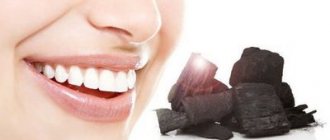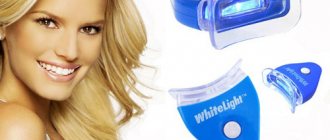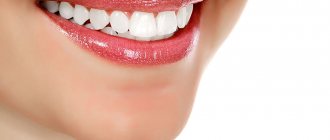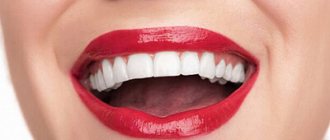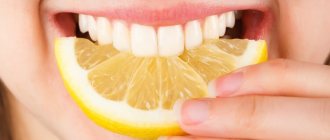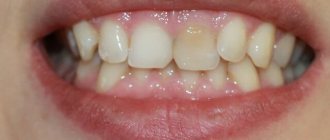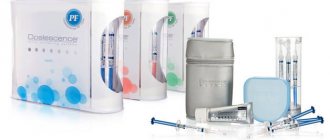Teeth whitening with folk remedies is an eternal topic, because an aesthetic trip to a professional does not fit into the format of insurance medicine. We have to shell out a large sum, and finances have been awarded the Golden Gramophone in the romance category for years. If this sounds like you, then you can try whitening your teeth using foil at home. But before you do, please read this nerdy but true warning:
- If you have sensitive teeth (they react with pain when eating hot, cold, sour, etc.), do not whiten them yourself using any recipes! Sensitivity indicates insufficient tooth enamel, and any whitening procedures harm it, that is, they weaken the natural protection of the teeth. Look for an alternative to modern teeth whitening under the supervision of a specialist.
- Do not repeat the procedure too often (no more than once a month, and better - twice). The pursuit of beauty can turn into a terrible force that destroys tooth enamel. Ideally, replace all these grandma’s methods with something that is guaranteed and safe to bring results.
So how do you whiten your teeth with foil and toothpaste? Need to stock up:
- Food foil;
- Toothpaste;
- Salt (table salt);
- Soda.
The procedure is simple: we make two wide strips of foil, each of which will cover the lower and upper teeth. Prepare the solution: squeeze out the paste (for measuring, you can use the lid of a five-liter canister of water). Pour a quarter teaspoon of salt and the same amount of soda into it. Mix and distribute the resulting mixture around the perimeter of the foil. Place it on your teeth (for 15 minutes). Then we wash it off, rinse our mouth, brush our teeth as usual and get a visible effect. Here's another recipe from my home repertoire.
How to extend the whitening effect for a long time?
Don't start your morning with coffee and stop smoking. You should also avoid excessive consumption of strong tea and other coloring drinks and sauces. The more neutral the diet, the longer the result will last.
This life hack is perhaps the most gentle whitening method of all that you can do yourself at home (here is another alternative). We know all the components (except, perhaps, soda) very well and consume them daily. But this does not mean at all that you can abuse this and uncontrollably indulge in folk and homemade things. It is best to go to a free district clinic and talk with a specialist before making a final decision.
Here is the result of bleaching with foil - before and after:
Tags: life hack, folk remedies, whitening, recipe
About the author: DrZubastik
- Related Posts
- How to rinse your gums at home if they are inflamed?
- Toothache without pills: how to relieve it?
- How to remove tartar using hydrogen peroxide?
« Previous entry
Properties of soda
Sodium bicarbonate can disinfect surfaces as an antiseptic, which is good for whitening
The unique properties of soda have made the product popular in various areas of human life, this is explained by the three main properties of the powder: antiseptic, regenerating, cleansing.
Antiseptic properties
Sodium bicarbonate can disinfect surfaces as an antiseptic.
This property has a positive effect on enamel whitening. Thanks to him, the procedure prevents harmful bacteria from entering the oral cavity.
Regenerating properties
Sodium accelerates skin regeneration by affecting metabolic processes in cells. When teeth whitening, it has a beneficial effect on the condition of the gums and improves their condition.
Cleansing properties
Large powder particles are capable of removing a thin layer of the surface. This applies to both plaque and tooth enamel. Soda owes its instant effect to this property.
Why does tooth enamel darken?
There can be many reasons for darkening of tooth enamel. The most common include:
- Failure to comply with hygiene rules. If you don't brush and floss your teeth, plaque, consisting of food debris and pathogenic bacteria, accumulates on the surface of your teeth. Over time, the plaque thickens, creating a dark “shell” that changes the natural color.
- Smoking. Smokers most often suffer from rapid yellowing of the enamel, which occurs due to deposits of resins contained in tobacco smoke. Smoking negatively affects not only the condition of the enamel, but also provokes the development of caries, stomatitis and other problems.
- Frequent consumption of coffee, black tea, wine and juices. These drinks negatively affect the color of teeth due to the large number of dyes. You can drink coffee and tea, but you must use a special toothpaste.
Preliminary actions
Before starting the procedure, it is important to prepare the oral cavity for the aggressive effects of soda:
- If your usual diet is not filled with products containing fluoride and calcium, you need to introduce them into the menu a month in advance
If your usual diet is not filled with products containing fluoride and calcium, you need to introduce them to the menu a month in advance. These include fermented milk products, cereals, seafood, apples, grapefruits, potatoes and greens.
- Fluoride strengthens tooth enamel. Special toothpastes, which are sold in pharmacies, will help increase its content. Daily use will strengthen the tooth shell, and whitening with soda will not cause negative consequences.
- Macroelements also ensure dental health. There are not enough of them in the daily diet - vitamin complexes come to the rescue.
The main goal of these actions is to strengthen tooth enamel, because it takes the brunt of aggressive environmental influences.
Perhaps improving the condition of the shell will completely eliminate the need for bleaching. Ignoring the above points often leads to the destruction of enamel and caries.
How many shades can you bleach?
Whitening with sodium bicarbonate cannot provide the same results as in-salon treatments. It gives the enamel its natural color, so you can whiten your teeth by only 1-2 shades with soda. To ensure that the procedure does not harm your health, it must be carried out competently.
Coffee, tea, wine and other drinks leave dark stains on teeth that change color over time. Smoking also makes teeth unattractive. Even with daily cleaning with whitening pastes, these unsightly marks cannot be eliminated.
Some people even doubt whether it is possible to whiten teeth with regular soda. There are known cases of unsuccessful attempts to use baking soda to clean teeth, which led to the development of caries and increased sensitivity. To avoid repeating similar mistakes, you should carefully study the issue of its use before turning to soda.
First of all, it should be understood that sodium bicarbonate cannot be called a harmless substance. At its core, it is a slightly alkaline compound, an abrasive that is capable of scraping various contaminants from surfaces.
If tooth enamel is frequently exposed to abrasives, its surface may become rough and porous, begin to thin out, and become especially sensitive.
Handle soda with care.
How to whiten teeth with baking soda at home?
Teeth whitening at home with sodium bicarbonate is a simple procedure that does not require special skills. The constant desire to improve the result has given rise to several dozen ways.
Cleaning with soda
The whitening procedure with soda without impurities is carried out in two ways:
- Using dry soda: Apply a moderate amount to a bandage, toothbrush or fingers.
Gently brush your teeth, then rinse your mouth with water. Important: the bandage or cotton swab must be damp. - Using a concentrated solution: Dissolve baking soda in water until the powder dissolves. Brush your teeth with a cotton swab dipped in the mixture. Rinse with water.
This is a simple teeth whitening option that works for everyone. To improve the taste sensation during the procedure, soda is sometimes mixed with toothpaste.
Gently brush your teeth with dry soda, then rinse your mouth with water.
Baking soda + toothpaste
Baking soda and toothpaste are mixed in 1:1 proportions. The mixture is applied to a toothbrush or cotton pad. Next is the most gentle process of brushing your teeth.
Dentists are often skeptical about this method, since soda can eliminate the effect of individual components of the paste. This does not affect whitening in any way.
Baking soda and toothpaste are mixed in proportions 1:1
+ tooth powder
Tooth powder has the same properties as toothpaste and itself acts as a whitener. Some powders already contain baking soda, so it's best to read the label carefully before mixing the two.
If there is no sodium bicarbonate in the ingredients, you can mix the powder and soda in a 1:1 ratio, apply it to a damp cotton or gauze swab and carefully rub it over the surface of the teeth.
Some powders already contain baking soda, so it's best to read the label carefully before mixing the two.
+ hydrogen peroxide
This mixture is aggressive in nature. It negatively affects tooth enamel. Dentists do not recommend resorting to this method to eliminate the risk of tooth decay.
But in isolated cases, when there is an urgent need for quick whitening, it is allowed to resort to cleaning with such a mixture.
To do this you need:
- Mix 3% peroxide solution and baking soda to obtain a thick paste.
- Apply the mixture with your fingers or a cotton swab to your teeth, being careful not to touch your gums - this will cause irritation.
- Massage for no longer than two minutes and rinse with water.
Important: using a toothbrush is strictly prohibited, as in this case the effect on the enamel will be irreversible.
Dentists do not recommend using hydrogen peroxide to eliminate the risk of tooth decay
+ lemon
The use of this method is dangerous for dental health, but to a lesser extent. For such bleaching, a pinch of baking soda is applied to gauze, a cotton pad or fingers, and the powder is moistened with a few drops of lemon juice on top. Carefully brush your teeth. Wash off with water.
You can whiten your teeth using baking soda and lemon juice.
Baking soda + hydrogen peroxide + lemon
This mixture is suitable for weekly home whitening and provides immediate visible results.
To prepare it correctly you need:
- Mix 0.5 teaspoon each of baking soda and lemon juice with a few drops of 3% hydrogen peroxide solution.
- Apply the mixture to your teeth using your finger or a cotton swab and leave for 2-3 minutes.
Important: avoid getting the mixture on your gums, as this may cause irritation. - Spit, rinse mouth with warm water.
The mixture is suitable for weekly home whitening and produces immediate visible results.
+ strawberry
This recipe requires fresh strawberries, so it is considered seasonal.
To prepare you need:
- Mash 2-3 berries and mix with half a teaspoon of soda powder.
- Apply the mixture to a soft-bristled brush or cotton pad and spread it over the surface of your teeth in a circular motion.
- Leave for 5 minutes.
- Rinse your mouth and brush your teeth with toothpaste.
Mash 2-3 berries and mix with half a teaspoon of soda powder
+ vinegar
The taste of vinegar is unpleasant, so not everyone will like this method of whitening a smile. But those who decide will appreciate the result.
Whitening procedure using this method:
- Pour baking soda into a bowl and add acetic acid until the consistency of toothpaste is achieved.
- Apply the mixture to your teeth using a brush, fingers or a cotton swab.
- Wait 5-10 minutes.
- Rinse your mouth with water and brush your teeth as usual.
The taste of vinegar is unpleasant, so not everyone will like this method of whitening a smile.
+ foil
To use this method you need foil, salt, baking soda and toothpaste. This is a long method and requires precision and patience. But the result justifies the means.
Instructions:
- Make molds out of food foil to cover your teeth.
- Prepare the mixture: mix toothpaste, baking soda and salt in proportions 2:1:1.
- Place the paste into foil molds and place them on your teeth. Leave for 15 minutes.
- Rinse your mouth thoroughly and brush your teeth.
Place the paste in foil molds and place them on your teeth.
+ salt
This is the most gentle way to achieve a snow-white smile, because the soda crystals are not rubbed into the teeth - they are dissolved. Whitening occurs by rinsing the mouth with a solution.
As a result, in addition to lightening the enamel, pathogenic microbes that live in the mouth are destroyed. There is no specific recipe: salt and soda are taken in such quantities that the solution is neither weakly nor highly concentrated. Rinse for a minute or two.
This is the most gentle way to achieve a snow-white smile because the soda crystals are not rubbed into the teeth.
+ coconut oil
Coconut oil is used to prevent oral diseases. It disinfects mucous membranes, prevents caries, and destroys bacteria that cause plaque.
To improve the effect, the oil is mixed with soda in a 1:1 ratio. Then apply the mixture to the brush and gently brush your teeth.
Coconut oil is used to prevent oral diseases
What whitening methods are there?
The dentist will advise which teeth whitening is safe for each patient individually. But everything that takes place under the supervision of a doctor will definitely not harm - there is no doubt about it, especially when using the latest technologies, delicate compounds and modern developments.
Professional teeth whitening methods:
- Photobleaching;
- laser whitening;
- whitening gel only;
- hardware method.
The first two methods use a lamp or laser as a catalyst for the action of the whitening gel.
Photobleaching, for example, ZOOM, enhances the effect of active hydrogen peroxide, helping to quickly break it down into free radicals - oxygen atoms. of up to 10 tones occurs.
. With proper care, the results last for several years.
The laser procedure differs in that instead of a light beam, a laser beam acts. It can heat the surface, which causes sensitivity (everything is in the hands of a professional doctor, since the advantage of a laser is accuracy), and copes well with changing color by 10-12 tones
and maintaining it for up to 5 years. The downside is the high cost of the method.
Dentists are still arguing about what is the safest teeth whitening, and whether laser and light are necessary for the best results. But it has been proven that the method of applying gel without using them is also effective. Opalescence technology with 40% hydrogen peroxide in the gel is cheaper in price and has proven itself in aesthetic dentistry.
A simple dental cleaning at the clinic is often sufficient for many people. After removing stones and plaque, the teeth become several shades lighter. Using one of these methods:
- Air-Flow hardware cleaning (the principle is similar to a sandblasting machine, but instead of sand, soda);
- ultrasound.
You can be satisfied with the result of your renewed smile.
Pros and cons of using soda
When used in excess, baking soda has negative consequences.
Before carrying out the procedure, you need to consider the pros and cons of the chosen method.
The first include:
- availability of funds;
- achieving instant results;
- the ability to carry out the procedure at home without prior preparation.
Negative sides:
- the result is short-lived;
- Baking soda damages tooth enamel and makes it thinner. This provokes the appearance of unpleasant sensations when eating hot or cold food;
- if used excessively, it has negative consequences: bleeding gums, inflammation of the oral mucosa and allergic rashes on the surrounding skin.
Save the result
Now that your teeth are clean, it's time to think about how to strengthen and maintain their whiteness for a long time. There are a few simple rules to follow after whitening.
What you need to do to make the whitening results last longer:
- carry out high-quality brushing of teeth at least 2 times a day;
- carefully remove food debris, brush your teeth with floss or brushes;
- prevent the accumulation of plaque and bacteria in the mouth;
- try to quit smoking, because nicotine darkens your teeth;
- After tea and coffee, be sure to brush your tooth enamel;
- regularly treat dental diseases.
Any whitening procedure quickly gives the desired result, but this is only a temporary effect. Constantly whitening your teeth is not an option, because this procedure will gradually destroy them. In order for the enamel to retain its natural whiteness for a long time, it must be carefully taken care of. Try to visit the dentist twice a year and do not overuse at-home whitening.
Source
Contraindications
Teeth whitening with soda powder is a serious procedure with a number of contraindications:
- Bleeding gums;
- Inflammation in the oral cavity, stomatitis, ulcers;
- Increased sensitivity of teeth;
- Thin enamel.
Using baking soda will worsen the problems listed above. If nothing on the list bothers you, you can whiten your teeth yourself.
However, a consultation with a dentist will not be superfluous - a specialist will examine the current condition of the teeth and oral mucous membranes and take into account the individual characteristics of the patient.
Teeth whitening with soda - before and after the procedure
Making a mouth guard from foil
Now you need to make a dental guard. For this you will need regular table foil. How to do it correctly:
- Cut a rectangular piece of foil measuring 10 by 5 cm.
- Fold the material in half lengthwise to make the mouth guard strong.
- Bend the rectangle lengthwise at an angle.
- Place a teaspoon of whitening solution in the tray.
- Place it on the top row of teeth.
- Press well so that the tray tightly envelops the crowns.
- Do the same with the second row of teeth.
Leave the mouth guard for a while, wait until the reagents dissolve the plaque. The foil should remain on the teeth for at least 20-30 minutes. Then you need to remove the strips from your teeth, brush your teeth, and rinse your mouth thoroughly. To freshen your breath, you can rinse your mouth again with a special dental solution.
There is a small warning for those who are interested in how to whiten teeth with soda solutions, foil and toothpaste. The fact is that the whitening procedure can be quite unpleasant. The entire time the trays are in your mouth, you may experience severe drooling and the taste in your mouth will be disgusting. But the result you will see after the procedure is worth it.
